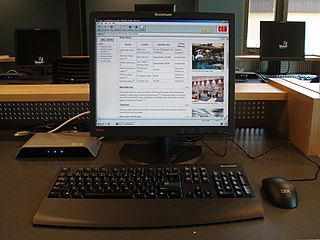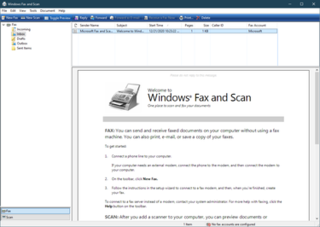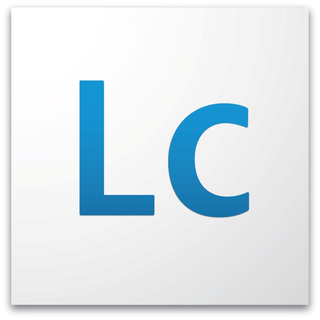
Fax, sometimes called telecopying or telefax, is the telephonic transmission of scanned printed material, normally to a telephone number connected to a printer or other output device. The original document is scanned with a fax machine, which processes the contents as a single fixed graphic image, converting it into a bitmap, and then transmitting it through the telephone system in the form of audio-frequency tones. The receiving fax machine interprets the tones and reconstructs the image, printing a paper copy. Early systems used direct conversions of image darkness to audio tone in a continuous or analog manner. Since the 1980s, most machines transmit an audio-encoded digital representation of the page, using data compression to transmit areas that are all-white or all-black, more quickly.

In computer networking, a thin client, sometimes called slim client or lean client, is a simple (low-performance) computer that has been optimized for establishing a remote connection with a server-based computing environment. They are sometimes known as network computers, or in their simplest form as zero clients. The server does most of the work, which can include launching software programs, performing calculations, and storing data. This contrasts with a rich client or a conventional personal computer; the former is also intended for working in a client–server model but has significant local processing power, while the latter aims to perform its function mostly locally.

An MFP, multi-functional, all-in-one (AIO), or multi-function device (MFD), is an office machine which incorporates the functionality of multiple devices in one, so as to have a smaller footprint in a home or small business setting, or to provide centralized document management/distribution/production in a large-office setting. A typical MFP may act as a combination of some or all of the following devices: email, fax, photocopier, printer, scanner.
Junk faxes are a form of telemarketing where unsolicited advertisements are sent via fax transmission. Junk faxes are the faxed equivalent of spam or junk mail. Proponents of this advertising medium often use the terms broadcast fax or fax advertising to avoid the negative connotation of the term junk fax. Junk faxes are generally considered to be a nuisance since they waste toner, ink and paper in fax machines.
A fax server is a system installed in a local area network (LAN) server that allows computer users whose computers are attached to the LAN to send and receive fax messages.
As the next version of Windows NT after Windows 2000, as well as the successor to Windows Me, Windows XP introduced many new features but it also removed some others.
Pagination, also known as paging, is the process of dividing a document into discrete pages, either electronic pages or printed pages.
Internet fax, e-fax, or online fax is the use of the internet and internet protocols to send a fax (facsimile), rather than using a standard telephone connection and a fax machine. A distinguishing feature of Internet fax, compared to other Internet communications such as email, is the ability to exchange fax messages with traditional telephone-based fax machines.
Centralized computing is computing done at a central location, using terminals that are attached to a central computer. The computer itself may control all the peripherals directly, or they may be attached via a terminal server. Alternatively, if the terminals have the capability, they may be able to connect to the central computer over the network. The terminals may be text terminals or thin clients, for example.
Desktop virtualization is a software technology that separates the desktop environment and associated application software from the physical client device that is used to access it.
A web desktop or webtop is a desktop environment embedded in a web browser or similar client application. A webtop integrates web applications, web services, client–server applications, application servers, and applications on the local client into a desktop environment using the desktop metaphor. Web desktops provide an environment similar to that of Windows, Mac, or a graphical user interface on Unix and Linux systems. It is a virtual desktop running in a web browser. In a webtop the applications, data, files, configuration, settings, and access privileges reside remotely over the network. Much of the computing takes place remotely. The browser is primarily used for display and input purposes.

Windows Fax and Scan is an integrated faxing and scanning application introduced in Windows Vista and included in the Business, Enterprise, and Ultimate Windows Vista editions as the replacement for the Fax Console of Windows XP; it is available in all versions of Windows 7, Windows 8, Windows 10 (x86/x64) and Windows 11 (x64), but not on ARM64 versions of Windows 10 and Windows 11.

Adobe LiveCycle Enterprise Suite (ES4) is a service-oriented architecture Java EE server software product from Adobe Systems used to build applications that automate a broad range of business processes for enterprises and government agencies. LiveCycle ES4 is an enterprise document and form platform that helps you capture and process information, deliver personalized communications, and protect and track sensitive information. It is utilized for purposes such as account opening, services, and benefits enrollment, correspondence management, requests for proposal processes, and other manual-based workflows. LiveCycle ES4 incorporates new features with a particular focus on mobile devices. LiveCycle applications function in both online and offline environments. These capabilities are enabled through the use of Adobe Reader, HTML/PhoneGap, and Flash Player clients to reach desktop computers and mobile devices.
A home server is a computing server located in a private computing residence providing services to other devices inside or outside the household through a home network or the Internet. Such services may include file and printer serving, media center serving, home automation control, web serving, web caching, file sharing and synchronization, video surveillance and digital video recorder, calendar and contact sharing and synchronization, account authentication, and backup services. In the recent times, it has become very common to run literally hundreds of applications as containers, isolated from the host operating system.
IBM Lotus Expeditor is a software framework by IBM's Lotus Software division for the construction, integration, and deployment of "managed client applications", which are client applications that are deployed from, configured, and managed onto a desktop, usually by a remote server. The goal is to allow developers to create applications that take advantage of running on a local client, while having the same ease of maintenance as web-based applications.
Biscom, Inc. is a privately held software company founded in 1986. Headquartered in Westford, MA, its main focus is providing secure document delivery solutions to regulated industries.
Documentum is an enterprise content management platform currently developed by OpenText. EMC acquired Documentum for US$1.7 billion in December 2003. The Documentum platform was part of EMC's Enterprise Content Division (ECD) business unit, one of EMC's four operating divisions.
InstallFree Inc. is a privately held company, backed by Ignition Partners and Trilogy Equity Partners, with headquarters in Stamford, CT and offices located worldwide. It was acquired by WatchDox. in December 2012. InstallFree specializes in Application Virtualization and delivery, based on their proprietary application virtualization technology that works on a variety of Microsoft Windows platforms such as Windows XP, Windows Vista, Windows 7, Windows Server 2003, Windows Server 2008, Terminal Server and Citrix XenApp.
Ciright Systems is an information technology services company based in West Conshohocken, Pennsylvania United States. Its flagship product is a Platform As A Service (PaaS) based Interoperable Cloud Platform that provides office and business automation to small and medium-sized businesses. The Ciright Platform also provides immediate mobile extendability to an enterprise's legacy system.

GroupWise is a messaging and collaboration platform from OpenText that supports email, calendaring, personal information management, instant messaging, and document management. The GroupWise platform consists of desktop client software, which is available for Windows,, and the server software, which is supported on Windows Server and Linux.



